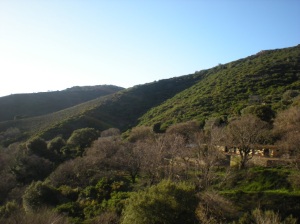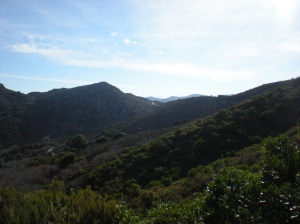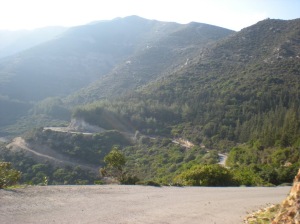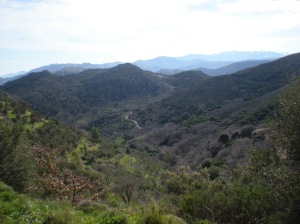I dream of living in an ecovillage and of similar villages and communities sprouting all over the world. Below is a short overview of the village I`d like to live in. If you would also like to live in such a place, please contact me at ivooglaid(at)gmail.com.
***
This is a dream, a vision and a reality in the process of realizing:)
Lannu village is a sustainable combination of an ecovillage and a traditional Estonian village. Above all it is home for the people who live here. At the same time, it is also a place where good ideas and examples sprout.
Ecological side or what makes Lannu an ecovillage
*organic gardening
Big part of the inhabitants` food is grown on the spot and it is possible to sustain oneself by eating only local foods. No chemicals that damage nature are used in Lannu gardens and homes. There are many ways to garden organically, everyone can choose the way that suits them best whether it`s the Masanobu Fukuoka, Anastasia, Robert Hart way, permaculture or acting on intuition. Food is grown in cooperation with nature, not fighting against it. There are no large fields of monocultures in Lannu and heavy machines don`t drive around here.
Animals are free-range. Animals are not raised for meat and there is no hunting. Being vegetarian is not a prerequisite for living here though environment is conducive to that. The amount of not-for-meat animals in a farm is reasonable so that the farmer can take care of them without damaging nature;
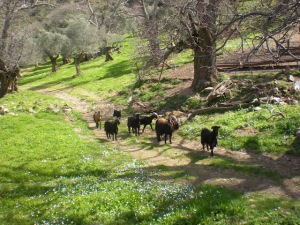
Ok, so I made this photo while in Crete. But goats have enjoyed a growing popularity with small-scale farmers in Estonia and they look pretty much the same here.
*CSA (Community-Shared Agriculture)
Different options are possible. Several families can garden together or one family can grow food for many families in and near the village. Perhaps some families wish to join a farmer`s “club” and get part of everything that grows in the farm through the year. For example, I`m not very interested in growing potatoes and keeping bees and I don`t use a lot of potatoes and honey, either. But I would be interested in helping someone else grow potatoes and get my share for that. At the same time I`m interested in growing lot`s of different fruit trees that grow more fruit than my friends and family can eat. Then it would be great if someone came and picked their share and brought me honey or some other conserves. Every family still has their own garden where they grow whatever they like;
*sharing where duplication has no deeper meaning. For example, a shared laundry house. Having a laundry house does not mean that inhabitants are forbidden to have a washing machine at home. It is a chance to not have 5 washing machines and electricity circuits when 1 can do the job. It would be even better if someone invented a washing machine that would make clothes clean without eating electricity, making lot`s of noise or using damaging chemicals and human strength:) That would be sustainable even in every home. Later when we have more people to go somewhere together, we might get a bus. Library;
*nature- and humanfriendly building with emphases on local options and passive solutions.
As much as possible, old farmplaces are used and new homes are built considering the logic of place and without damaging the place. Wind direction and the moving of sun is considered. If water is brought inside the house, pipes are not spread in different places around the house and homes are not enwrapped in electric circuit. Materials that easily become part of nature after end of use, are used. Natural light is used maximally and the warmth of sun is collected. Greenery is not damaged for building, land is not turned upside down around the house and loud noise is not made. Expensive and complicated “ecotechnology” that does not compost later and causes problems instead, is not used. Inhabitants build their own homes with the help of each other, friends and local craftsmen. The goal is not austerity but finding simple and smart solutions that are kind to nature and humans. For example, reflecting light, walls that collect heat, refrigerator inside the north wall, earth cellar and pantry, hot water tap attached to the pot inside a stove, rainwater reservoir so high that it can be used for showering in the summer or the water could be directed to kitchen;
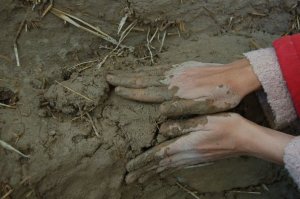
Picture from a Cob building workshop. Nothing beats the joy of creating something real with your own hands.
Social side or what keeps the Lannu community together
A well functioning community is a set of people that are tightly involved and help each other. Community is bigger than family and could represent a small model of society. The amount of people that could be considered one`s community is limited. When there are too many people, connections weaken and relationships only touch the surface.
Community stays strong if it`s members:
*enjoy spending time together and communicating with each other;
*communicate freely often;
*spend time close to each other often, for example visits, house-raising and other work parties, hiking together, children staying overnight, cake- and handicraft nights…;
*know and trust each other enough to share personal information;
*start and keep shared traditions in both smaller neighborhoods and the whole village, for example, greeting new inhabitants with a personal visit and a party, celebrating together, fall hike, spring hike…;
*everyone feels important and needed in the community;
*share values and accept differences (don`t try to force themselves into circles whose values or ways they can`t accept);
*help each other and share what they`ve learned and created;
*speak about both light and heavy issues;
The critical point between a dream and a reality is the feeling that my life is here. As long as it seems great and I`d like to but really my life and work and friends are elsewhere, nothing changes. When here and there change places so that the inhabitants` life is in the village and other places are only visited, then village is strong and viable.

Photo from Estonian Home Education Summer Camp 2011.
An important part of the social side is education.
At Lannu village we have community home education. This means:
1)children naturally grow in a community that consists of people in different agegroups,
2)they have contact with people from different fields of life and can learn from them and
3)they can give their contribution to the community.
In a functioning community there are all possibilities to grow into an active member of society. Realizing the possibilities is only a question of choices of the people living here.
We don`t have our own school or kindergarten in a traditional sense. If some families don`t want home education, there`s always the option of the closest local school. Several communities in Estonia are already considering creating their own school. We are concentrated on home education:)
We do have a village center where villagers in all ages that have something to offer, can hold and participate in workshops, courses, art exhibits… and also events for wider publicity. Camps and courses on everything organic take places in the village.
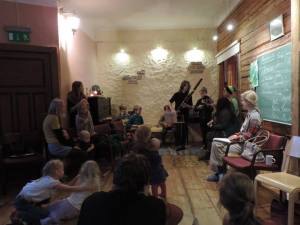
Estonian Home Education Winter Day 2014 at Rakvere Old Town School. Photo by Kristiina Isakar.
Spiritual side or shared values and basic principles
*contact with nature, sustainability, organic thinking is important;
*human relations are important.
Every family lives in their own home, yet we are still a whole community. No one has to feel lonely living in Lannu village;
*home and family centered.
Growing roots is supported. Children are welcome. We support growing strong families. Every family is a whole and lives in it`s own home. A commune can only be a temporary arrangement, for example, while building homes. Environment is conducive to several generations living together. We expect that people come here to create a permanent home, the kind they could leave to grandchildren. That`s why no one is asked to sign papers that would give a seeming right to ask someone to leave the village at some point. This also means that building homes can`t be started overnight. Before deciding to stay here, potential villagers have to live here as a guest at least a few months to be certain that they really want to create their lives here, in this place and community;
*simple humanity;
*freedom
Freedom comes with responsibility and requires awareness and a goal. At Lannu village everyone has the freedom to create a sustainable corner of the world. Freedom to grow as a human being and open one`s potential is supported. Living in a village that supports freedom does not give anyone the kind of freedoms they don`t naturally have. For example, the freedom to decide that someone no longer wants to be a parent is not supported.
Everything is voluntary in that no one is forced to do anything. No one is coercively attached to a role to keep the village functioning and no one has to use the services provided by villagers. For example, having a midwife in the village (which would be great) does not mean that all families having a baby have to invite her;
*lifelong growing and development;
*slow lifestyle that allows concentration and growing on a deeper level;
*no fixed religion or doctrine.
Everyone can follow their practices as long as they don`t harm other people, nature and community. Converting others is not supported;
*the community is not centered around a spiritual leader.
Economical side
*Lannu is a real village that stands on the initiatives, actions and cooperation of families and individuals gathered together by shared goals and values. The viability and vivacity of the village is not dependant on the existence of a governing organization or some person`s change of plans. If at some point there are 10 households in the village, it is a strong village because a tight community of 10 families is much stronger and viable than 100 families that don`t trust each other and have opposing values.
A village is a living organism that needs to be cared for and helped to grow. By putting lot`s of energy and attention into it in the beginning, the village becomes self-sustainable and reproductive;
*every family is the sole owner of their land. The land under homes and gardens does not belong to any organizations. There may be some shared areas that belong to a non-profit created by the inhabitants;
*most of what goes on in the village is solved by individuals, families, farms, small businesses. Small eco-businesses are directed to villagers and elsewhere. It`s possible that an ngo is also needed when starting the village but it does not run the village and has no participation in home ownership;
*we strive for self-sustainability inside the village, in the level of a single farm, small neighborhood and the whole village;
*at the same time we are open to cooperation with other villages, craftsmen, organic farms, neighbourhoods, wider society;
*CSA inside the village and can also be directed to nearby parishes or towns;
*making and growing things ourselves;

Photo from a Cob building workshop I participated in.
*work-parties;
*exchanging services;
*sharing a car, if needed;
*shared laundry house, library, community center, perhaps something more;
*no member fees. When there`s a need for shared expenses, means can be collected;
*the village might have it`s own money but it would be easier without it;
*villagers with diverse skills. It would be great to have people who can help others learn about organic gardening, natural building, woodwork, blacksmithing, herbs, birth and pregnancy assistance, traditional crafts, organic cooking, organic housekeeping, ceramics… Animal therapy and other creative therapies would be welcome. I hold courses and write books on creating life-supporting homes and making dreams come true and make textiles by hand. For the past 9 years I have organized events for the Estonian Center for Home Education and counselled parents wishing to home educate their children. (We`re going to celebrate 10 years of ECHE in the summer of 2015 with an international gathering. If you`d like to participate in creating that, write to me at ivooglaid(at)gmail.com.) My home page in Estonian is http://looduskodu.wordpress.com. At the village I will hold harmonious living and home education camps, summer- and other days, raise a few wool-goats, weave rugs and write. And I`m sure a lot of other things that will come in time;
*it is vital that people coming to live in an ecovillage have a clear idea how they are going to support themselves. It is not viable to move to the country depending on a single local employer. If that employer closes their business or moves away, then the people who came with the consideration they can get their income from him/her, are likely to move back to town and the whole village could collapse. To live in an ecovillage one has to be capable of providing their own work and income and be able to use time and energy to make their household sustainable in the long run, even when there`s no income for a while and when internet is not accessible for a while. An ecovillage is a great place to live and work toward improving the world locally and/or globally and it is best suited for people who have a strong vision and a high level of flexibility.
Village growing
*Lannu village grows slowly, so that there is time to get to know every new villager personally;
*people who already have organic thinking and who want to live here are invited and accepted as new villagers. Organic thinking means wanting and being willing to live without letting damaging chemicals into air and ground, for example washing liquids, fertilizers and building materials and without causing noise pollution;
*first new potential villagers live here as guests to be sure they really want to live here;
*we have a large amount of land from which new inhabitants buy a piece;
*land is bought without any bank loans. For that we first need to get hold of a big part of the land. When buying in large quantities, the price of m2 is not expensive and it is easy to by a few hectares from it later. We should get at least 30 ha for start and there should be several old farm-places near so other pieces can be bought later or individually by villagers. I`m sure there are nice landowners who would be glad if a village would bloom on their land and would be willing to sell under good conditions:)
*there are going to be a maximum of 100 homes is Lannu village. After that it`s other villages and 100 is also divided into at least 3 geographically distinct areas. Farms are located so that there are 2-5 close to each other, then a little distance and another 2-5. The village area is such that it is possible to visit everyone by foot;
*the face of the village changes as inhabitants do;
*representatives of all households are in the village council.

A photo of me with two of my brothers. Main part of my childhood was in the country, in South-Estonia. The sheep were not ours but neighbourhood offered plenty of opportunities to see different animals. And we had a small garden patch behind the window. The hats we`re wearing were hand-knitted by grandma.
Location:
*deep in the country, South Estonia, preferably Haanja-Rõuge area;
*walking distance from a bus stop;
* walking distance from a little bigger place where buses definitely come and to where CSA could be directed (Haanja and Rõuge are both great);
*hills and lakes and woods filled with berries and mushrooms;
*enough open views and cosy little glades at the same time;
*spring/brook with clean water;
*far from big roads, high-voltage lines, antenna towers and factories;
*suitable land for gardening.
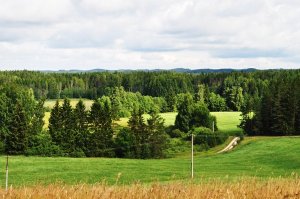
A view characteristic to Haanja-Rõuge area. Photo by Ivo Luik.
***
If you have made it all the way through the long text you probably have a similar dream yourself:) This is a preliminary sketch of what could be. I`m fully open to improvements and suggestions. If you`d like to talk about your dream, leave a comment or write to me at ivooglaid(at)gmail.com. Let`s make it a reality!
Meanwhile take care to get my free newsletter with tips on creating a haven, connect with me on Facebook and follow on Twitter.

